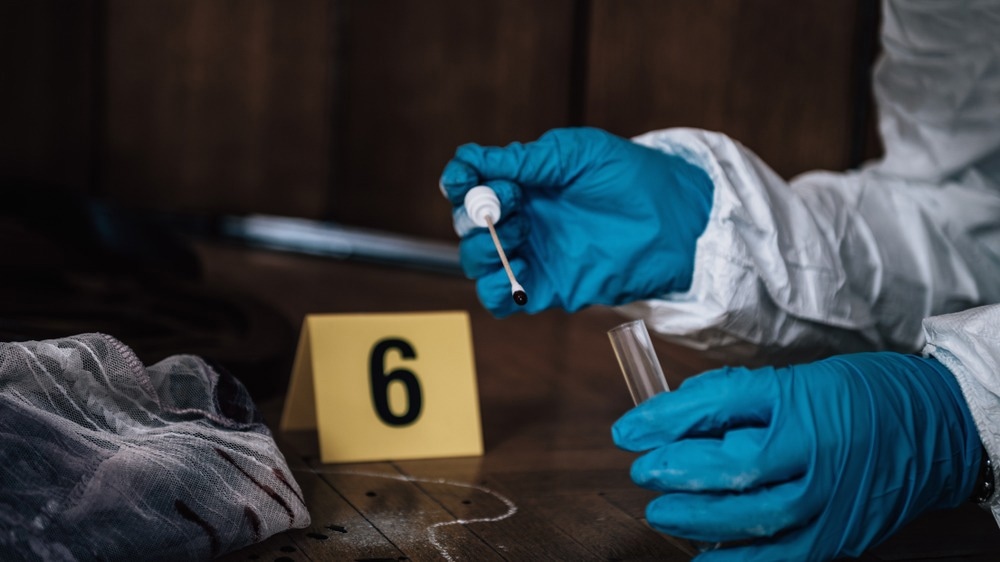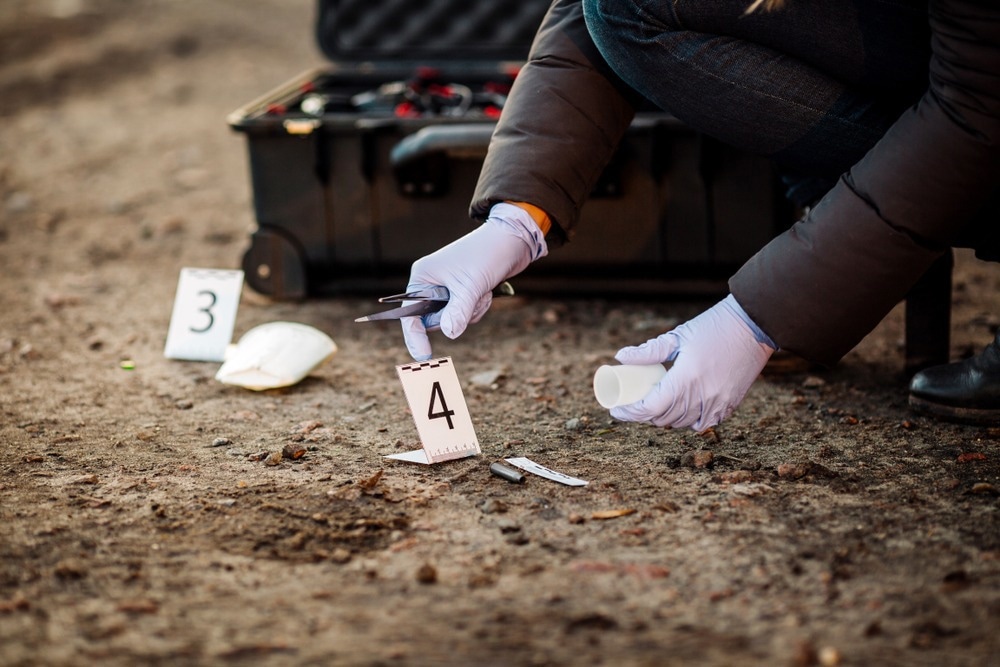Spectroscopy is a promising tool for characterizing compounds in many research fields. This analytical tool has created an unbroken bond with forensics and has evolved into the exclusive field of forensic spectroscopy. This article emphasizes the role of forensic spectroscopy in crime evidence analysis and provides an overview of the techniques involved.

Image Credit: Microgen/Shutterstock.com
Forensic Spectroscopy in Criminological Examination
In the modern era of forensic sciences, where samples at the crime scene are available in trace amounts, forensic spectroscopy has served as a non-destructive alternative to conventional destructive approaches in crime evidence analysis.
Forensic spectroscopy helps reveal various body fluids' chemical makeup using electromagnetic radiation. Comparing the resulting spectra with the molecular spectral library is the most convenient method for comprehending the chemical structure of the molecules in the sample.
Portable versions of forensic spectrometry instruments allow the analysis of a sample's chemical composition and structure without being removed from the crime scene. Moreover, because of the non-destructive nature of forensic spectroscopy, this technique is also used to analyze unknown samples that are potentially hazardous and expensive.
Overview of Forensic Spectroscopy Techniques
The following spectroscopic methods are currently used to analyze forensic samples based on the nature of the electromagnetic radiation used as an energy source:
Infrared (IR) Spectroscopy
IR spectroscopy is a label-free forensic spectroscopy technique with high chemical specificity and sensitivity. When exposed to IR energy, chemical molecules produce unique spectral data that can be compared with the spectra of forensic samples, allowing identification of the chemical composition of the sample.
Most of the samples in a crime scene are organic compounds, and IR-based forensic spectroscopy is a suitable method for analyzing the chemical composition of organic molecules, such as hair, paint, fuels, ink, and sweat.
This forensic spectroscopy method also helps in analyzing traces of building materials and gunshot residue and aids in the chemical characterization of fingerprint residues. Additionally, IR-based forensic spectroscopy can help identify fortified documents by projecting a beam of IR rays onto document ink.
A recent article published in ACS Omega reported the evaluation of drug mixing conditions using Fourier transform infrared (FT-IR) spectroscopy, followed by quantitative evaluation using relative content ratio (RCR) frequency histograms.
Here, p-hydroxybenzoic acid (PHBA) and bromhexine hydrochloride (BHCl) were mixed under four different conditions. The results revealed that the synchrotron radiation (SR) instrument could distinguish between mixing modes better than the globar light instrument.
Ultraviolet (UV) Spectroscopy
UV-based forensic spectroscopy is the most commonly used method for analyzing crime evidence. This technique allows a scientist to see evidence that is invisible to the naked eye, including fingerprints, sweat, oil, blood, bite marks, and body fluids.
UV-based forensic spectroscopy serves as a reliable method to confirm the presence of bloodstains. Blood absorbs UV light, does not reflect any fluorescence, and appears as a black stain.
This forensic spectroscopy also helps to analyze patterned injuries on the human skin. Moreover, the characteristic fluorescent patterns obtained through UV-based fluorescent spectrometry can help identify the nature of ignitable liquids in fire investigations.

Image Credit: PRESSLAB/Shutterstock.com
Nuclear Magnetic Resonance (NMR) Spectroscopy
NMR-based forensic spectroscopy is mainly used to analyze controlled drugs and identify intermediates and precursors. This forensic spectroscopy method has also been used to analyze metabolites and misused drugs, including fentanyl, cocaine, and cannabinoids.
Although most forensic spectroscopic techniques face challenges in quantitative analysis, NMR-based forensic spectroscopy sets itself apart by serving as a direct method for quantitative analysis by determining detectable nuclei.
This type of quantitative forensic spectroscopy is especially useful for the analysis of various psychoactive substances for which reference compounds are expensive. In addition to proton NMR (1H), other nuclei, such as carbon-13 (13C) and two-dimensional (2D) NMR-based forensic spectroscopy, are used to identify the presence of strychnine, a natural chemical weapon.
Recently, forensic spectroscopy has been equipped with affordable and compact benchtop NMR spectroscopy to identify and quantify forensic compounds at the crime scene.
Gas Chromatography-Mass (GC-MS) Spectroscopy
GC-MS-based forensic spectroscopy measures the mass-to-charge ratio of the ions in forensic samples. It is used to determine the involvement of a suspect in a case by analyzing the suspect’s particles, such as fire debris.
Additionally, this forensic spectroscopy method is used in anti-doping laboratories of sports academies to check for the presence of illegal steroids (performance enhancers) in an athlete's urine samples.
An article published in Scientific Reports reported the use of GC-MS spectroscopy to determine the presence of the anti-vertigo drug difenidol hydrochloride, which is misused in suicides and accidental poisonings, in biological specimens.
Raman Spectroscopy
Raman-based forensic spectroscopy has proven to be a promising technique for analyzing fibers, inks, explosives, body fluids, and gunshot residues. This technique does not require sample preparation, which allows for the preservation of samples, such as DNA extraction.
The primary advantage of Raman-based forensic spectroscopy over other spectroscopic techniques is that the analysis is not limited to any physical state of a sample. This allows for the analysis of solid, liquid, and gas samples.
Forensic spectroscopy is highly selective and produces signals with a sample size as low as femtoliter volume. Moreover, the portable Raman forensic spectroscopy instrument allows sample analysis at a crime scene or any other location.
Conclusion
Overall, forensic spectroscopy is a non-destructive analytical method with minimal sample requirements. Based on the nature of the sample, electromagnetic radiation within a particular wavelength range can be used to investigate crime scenes. The aforementioned forensic spectroscopy methods reinforce the potential applications of spectroscopy in forensic science.
More from AZoOptics: How is Spectroscopy Used to Analyze Fire Debris?
References and Further Reading
Brettell, T. A., Butler, J. M., Saferstein, R. (2005). Forensic science. Analytical chemistry, 77(12), 3839-3860. https://doi.org/10.1021/ac050682e
How is Infrared Spectroscopy Used in Key Forensics Applications? [Online] Available at https://www.azooptics.com/Article.aspx?ArticleID=1929 (Accessed on 15 July 2023).
Groombridge, C. J. (1996). NMR spectroscopy in forensic science. In Annual reports on NMR spectroscopy, 32, 215-297. https://doi.org/10.1016/S0066-4103(08)60080-0
Draper, S. L., McCarney, E. R. (2023). Benchtop nuclear magnetic resonance spectroscopy in forensic chemistry. Magnetic Resonance in Chemistry, 61 (2), 106-129. https://doi.org/10.1002/mrc.5197
Rao, T. R., Harshitha, S., Lahari, K. L. (2023). Gas chromatography-mass spectroscopy: an overview. European Journal of Biomedical, 10 (5), 83-89. https://www.researchgate.net/profile/Rama-Tadikonda/publication/371989508_GAS_CHROMATOGRAPHY-MASS_SPECTROSCOPY_AN_OVERVIEW/links/64a24ff1b9ed6874a5ee8cfa/GAS-CHROMATOGRAPHY-MASS-SPECTROSCOPY-AN-OVERVIEW.pdf
Yang, L et al. (2021). Application of a validated UPLC–MS-MS method for the determination of diphenidol in biological samples in 15 authentic lethal cases. Journal of Analytical Toxicology, 45 (9), 976-984. https://doi.org/10.1093/jat/bkaa160
Iwai, T et al. (2023). Forensic Discrimination of Drug Powder Based on Drug Mixing Condition Determined Using Micro Fourier Transform Infrared Spectroscopy. ACS omega, 8 (4), 4285-4293. https://doi.org/10.1021/acsomega.2c07573
Disclaimer: The views expressed here are those of the author expressed in their private capacity and do not necessarily represent the views of AZoM.com Limited T/A AZoNetwork the owner and operator of this website. This disclaimer forms part of the Terms and conditions of use of this website.